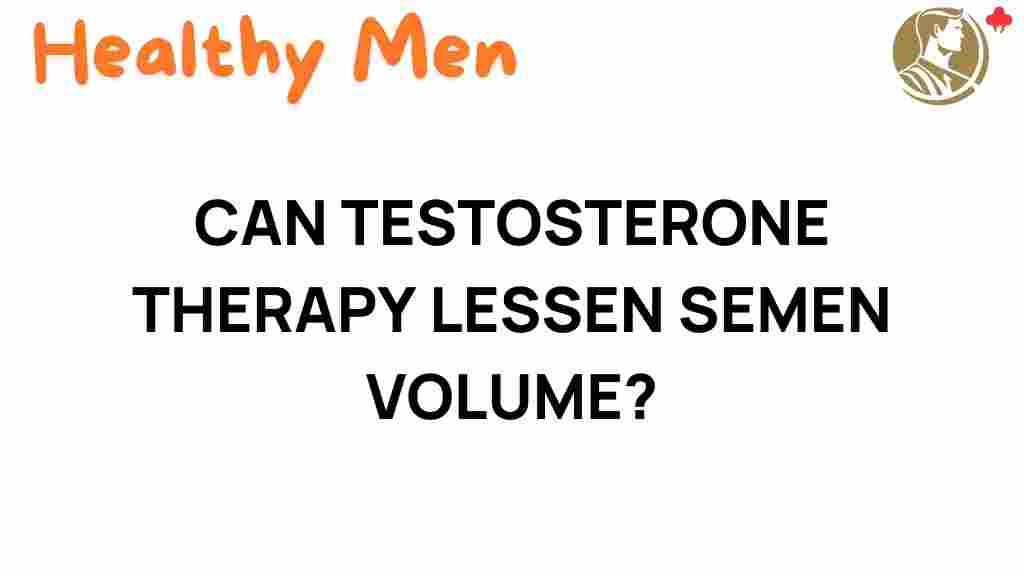Unraveling the Mystery: Does Testosterone Therapy Impact Semen Volume?
Testosterone therapy has gained significant attention in recent years, especially among men seeking to enhance their health and vitality. As men age, testosterone levels typically decline, leading to various health issues, including reduced libido, fatigue, and decreased muscle mass. However, one area that remains shrouded in uncertainty is the effect of testosterone therapy on semen volume—a crucial factor for male reproductive health. In this article, we will explore the intricate relationship between testosterone therapy, semen volume, and overall male health. We aim to provide insights that can help men make informed decisions regarding their hormone therapy and reproductive health.
Understanding Testosterone and Its Role in Male Health
Testosterone is a key hormone in male physiology, primarily produced in the testes. It plays a vital role in various bodily functions, including:
- Regulation of libido and sexual function
- Maintenance of muscle mass and strength
- Bone density and health
- Production of red blood cells
- Influencing mood and cognitive function
Healthy testosterone levels are essential for optimal male health and well-being. Low testosterone, or hypogonadism, can lead to symptoms such as low energy, depression, reduced sexual interest, and even infertility. Therefore, testosterone therapy is often prescribed to restore hormonal balance and alleviate these symptoms.
The Link Between Testosterone Therapy and Semen Volume
One of the most pressing questions regarding testosterone therapy is its influence on semen volume. Semen volume is a critical parameter in assessing male fertility, as it contains sperm and seminal fluid necessary for reproduction. Research on this topic has produced mixed results, leading to some confusion about the health impacts of testosterone therapy.
Studies suggest that testosterone therapy can lead to both increases and decreases in semen volume, depending on various factors, including:
- The method of administration (injections, patches, gels)
- The dosage and duration of therapy
- Individual physiological responses
How Testosterone Therapy Works
Testosterone therapy typically involves the administration of synthetic testosterone through various methods:
- Injections: Testosterone is injected directly into the muscle, providing a quick boost to hormone levels.
- Transdermal patches: These patches are applied to the skin, allowing testosterone to be absorbed into the bloodstream.
- Topical gels: Similar to patches, gels are applied to the skin but are often preferred due to their ease of use.
The primary goal of testosterone therapy is to elevate testosterone levels to a normal range, thereby alleviating symptoms associated with low testosterone. However, its impact on semen volume can vary significantly from one individual to another.
Step-by-Step Process: Evaluating the Impact of Testosterone Therapy on Semen Volume
To understand how testosterone therapy might affect semen volume, it is essential to consider the following steps:
- Consultation with a healthcare provider: Before embarking on testosterone therapy, a thorough evaluation by an endocrinologist or a healthcare professional specializing in male health is crucial. They will assess testosterone levels through blood work and discuss potential benefits and risks.
- Choosing the right therapy: Based on individual health needs, the healthcare provider will recommend a suitable form of testosterone therapy. This choice can significantly influence semen volume outcomes.
- Regular monitoring: Once therapy begins, regular follow-ups are essential to monitor testosterone levels, symptoms, and semen analysis. This helps ensure that the treatment is effective and safe.
- Adjusting therapy as needed: If semen volume decreases significantly or fertility becomes a concern, the healthcare provider might adjust the dosage or method of administration.
Research Findings on Testosterone Therapy and Semen Volume
Numerous studies have investigated the relationship between testosterone therapy and semen volume. Key findings include:
- Some studies indicate that testosterone therapy may reduce semen volume and sperm production due to negative feedback on the hypothalamic-pituitary-gonadal (HPG) axis.
- Other research suggests that certain forms of testosterone therapy, particularly those that maintain more stable hormone levels, might have a less detrimental effect on semen volume.
- Men who are already infertile may experience further decreases in semen volume with testosterone therapy, while those with normal fertility may not see significant changes.
Ultimately, the impact of testosterone therapy on semen volume is complex and varies among individuals. For those concerned about fertility, it is crucial to discuss these potential outcomes with a healthcare provider before starting treatment.
Potential Troubleshooting Tips
If you are undergoing testosterone therapy and have concerns about your semen volume or fertility, consider the following troubleshooting tips:
- Regular semen analysis: Have your semen analyzed periodically to monitor changes in volume and sperm count.
- Communicate openly with your doctor: Discuss any concerns about fertility or changes in sexual function with your healthcare provider.
- Consider alternative therapies: If testosterone therapy is affecting your semen volume, ask your doctor about alternatives, such as selective estrogen receptor modulators (SERMs) or human chorionic gonadotropin (hCG).
- Maintain a healthy lifestyle: A balanced diet, regular exercise, and avoiding smoking and excessive alcohol can support overall reproductive health.
Conclusion: Making Informed Decisions About Testosterone Therapy
Testosterone therapy can have significant health impacts on men, particularly those experiencing symptoms of low testosterone. However, the relationship between testosterone therapy and semen volume is nuanced and varies widely among individuals. While some may experience a reduction in semen volume, others may not see significant changes.
For men considering testosterone therapy, it is essential to have open discussions with healthcare providers, particularly regarding reproductive health and fertility concerns. Regular monitoring and adjustments to therapy can help maximize the benefits while minimizing potential negative impacts on semen volume.
Ultimately, informed decisions regarding testosterone therapy can greatly enhance male health and well-being. For further information on testosterone therapy and its effects, consider visiting reputable sources such as the Mayo Clinic or consulting with an endocrinologist specializing in male health.
By understanding the complexities of testosterone therapy and its potential impact on semen volume, men can take proactive steps towards achieving optimal reproductive health and overall well-being.
This article is in the category Conditions and created by healthymen Team
